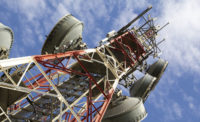- In Wichita, Kansas, a 25-year-old worker performing cell tower maintenance was killed when he fell 50 feet.
- In Louise, Mississippi, a worker installing microwave dishes on a cell tower was killed when he fell 125 feet. The worker, who was not using a double lanyard, fell after disconnecting his positioning lanyard to re-position himself.
- In Coats, NC, a worker performing installation services for Sprint died from a fall.
These incidents are vivid illustrations of why falls are the top cause of fatalities in the communication tower industry, which has grown dramatically over the past 30 years.
2,000 feet in the air
In order to erect or maintain communication towers, employees regularly climb towers, using fixed ladders, support structures or step bolts, from 100 feet to heights in excess of 1000 or 2000 feet. There’s no time off for inclement weather, either; workers climb towers throughout the year, sometimes in high winds and ice storms.
With the demand for wireless and broadcast communications continuing to increase, employment related to servicing and maintaining towers will also expand.
Falls not the only hazard
While falls from great heights are a primary hazard for these workers, they are not the only cause of workplace incidents. Others are: electrical hazards; hazards associated with hoisting personnel and equipment with base-mounted drum hoists; inclement weather, as noted above; falling object hazards; equipment failure and structural collapse of towers.
According to most recent data available from OSHA, the industry’s fatality rate was decreasing until an uptick in 2016, which saw six fatalities. There were three in 2015, 12 in 2014 and 13 in 2013.
An especially deadly year
The following are some of the 2013 communications tower incidents that were investigated by OSHA. They include one where a worker survived a 140’ fall, and another where one died despite having fall protection on:
- July 8, 2013, Monarch Towers, Mountrail County, ND. Two workers were adding structural supports to a 300 foot tower. One worker fell and struck the other, causing them both to die from a 250 foot fall.
- May 28, 2013, Byrd Telecom, Georgetown, MS. Workers were raising a new antenna to the top of a tower to make the tower taller. While installing a hoisting device to raise the boom a cable broke, causing two men to fall to their deaths.
- April 3, 2013, Excell Communications, Birmingham, AL. No fatality, injury - Worker survived a 140 foot fall.
- April 5, 2013, S25 Towerserv, LLC, Franklin, PA. Two employees were hoisting new equipment on a tower, one employee was at approximately 190 feet, the other at 140 feet. The equipment being hoisted came loose striking the lower employee causing him to fall.
- March 19, 2013, Eduardo Corona, Laredo, TX. While installing the last 10-foot section of a 90 foot tower, the bottom section collapsed, causing one employee to fall to the ground and die.
- January 4, 2013, Ws Consulting & Construction, Mount Vernon, Washington. Employee fell 80 feet and died, had fall protection gear on, but the fall protection anchorage point failed.
Resources
Preventing Injuries and Deaths from Falls during Construction and Maintenance of Telecommunication Towers (PDF). NIOSH Alert Publication Number 2001–156,(July 2001)
Communication Tower Best Practices [PDF] - OSHA/FCC Joint Publication. A guide to establish accepted practices for performing communication towers work safely. (June 2017).
Preventing Falls in Construction. OSHA's Fall Prevention Campaign.


